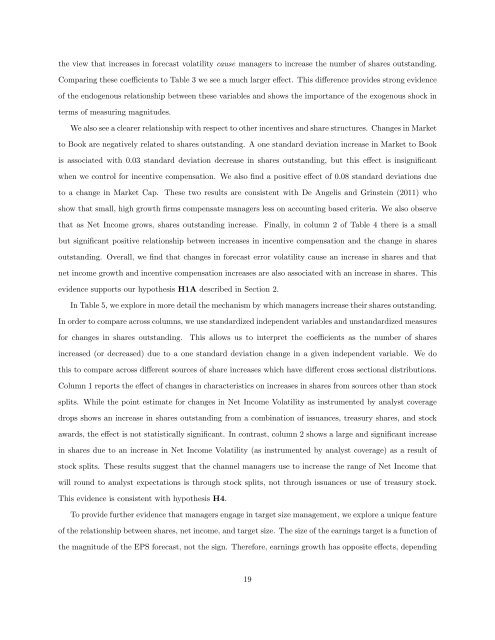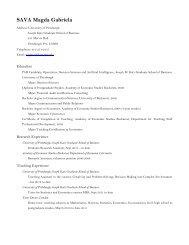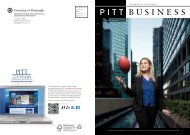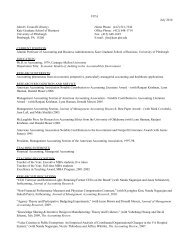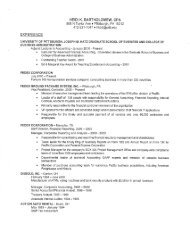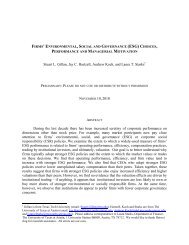Gaming the Float: How Managers Respond to EPS-based Incentives
Gaming the Float: How Managers Respond to EPS-based Incentives
Gaming the Float: How Managers Respond to EPS-based Incentives
You also want an ePaper? Increase the reach of your titles
YUMPU automatically turns print PDFs into web optimized ePapers that Google loves.
<strong>the</strong> view that increases in forecast volatility cause managers <strong>to</strong> increase <strong>the</strong> number of shares outstanding.<br />
Comparing <strong>the</strong>se coefficients <strong>to</strong> Table 3 we see a much larger effect. This difference provides strong evidence<br />
of <strong>the</strong> endogenous relationship between <strong>the</strong>se variables and shows <strong>the</strong> importance of <strong>the</strong> exogenous shock in<br />
terms of measuring magnitudes.<br />
We also see a clearer relationship with respect <strong>to</strong> o<strong>the</strong>r incentives and share structures. Changes in Market<br />
<strong>to</strong> Book are negatively related <strong>to</strong> shares outstanding. A one standard deviation increase in Market <strong>to</strong> Book<br />
is associated with 0.03 standard deviation decrease in shares outstanding, but this effect is insignificant<br />
when we control for incentive compensation. We also find a positive effect of 0.08 standard deviations due<br />
<strong>to</strong> a change in Market Cap. These two results are consistent with De Angelis and Grinstein (2011) who<br />
show that small, high growth firms compensate managers less on accounting <strong>based</strong> criteria. We also observe<br />
that as Net Income grows, shares outstanding increase. Finally, in column 2 of Table 4 <strong>the</strong>re is a small<br />
but significant positive relationship between increases in incentive compensation and <strong>the</strong> change in shares<br />
outstanding. Overall, we find that changes in forecast error volatility cause an increase in shares and that<br />
net income growth and incentive compensation increases are also associated with an increase in shares. This<br />
evidence supports our hypo<strong>the</strong>sis H1A described in Section 2.<br />
In Table 5, we explore in more detail <strong>the</strong> mechanism by which managers increase <strong>the</strong>ir shares outstanding.<br />
In order <strong>to</strong> compare across columns, we use standardized independent variables and unstandardized measures<br />
for changes in shares outstanding.<br />
This allows us <strong>to</strong> interpret <strong>the</strong> coefficients as <strong>the</strong> number of shares<br />
increased (or decreased) due <strong>to</strong> a one standard deviation change in a given independent variable. We do<br />
this <strong>to</strong> compare across different sources of share increases which have different cross sectional distributions.<br />
Column 1 reports <strong>the</strong> effect of changes in characteristics on increases in shares from sources o<strong>the</strong>r than s<strong>to</strong>ck<br />
splits. While <strong>the</strong> point estimate for changes in Net Income Volatility as instrumented by analyst coverage<br />
drops shows an increase in shares outstanding from a combination of issuances, treasury shares, and s<strong>to</strong>ck<br />
awards, <strong>the</strong> effect is not statistically significant. In contrast, column 2 shows a large and significant increase<br />
in shares due <strong>to</strong> an increase in Net Income Volatility (as instrumented by analyst coverage) as a result of<br />
s<strong>to</strong>ck splits. These results suggest that <strong>the</strong> channel managers use <strong>to</strong> increase <strong>the</strong> range of Net Income that<br />
will round <strong>to</strong> analyst expectations is through s<strong>to</strong>ck splits, not through issuances or use of treasury s<strong>to</strong>ck.<br />
This evidence is consistent with hypo<strong>the</strong>sis H4.<br />
To provide fur<strong>the</strong>r evidence that managers engage in target size management, we explore a unique feature<br />
of <strong>the</strong> relationship between shares, net income, and target size. The size of <strong>the</strong> earnings target is a function of<br />
<strong>the</strong> magnitude of <strong>the</strong> <strong>EPS</strong> forecast, not <strong>the</strong> sign. Therefore, earnings growth has opposite effects, depending<br />
19


